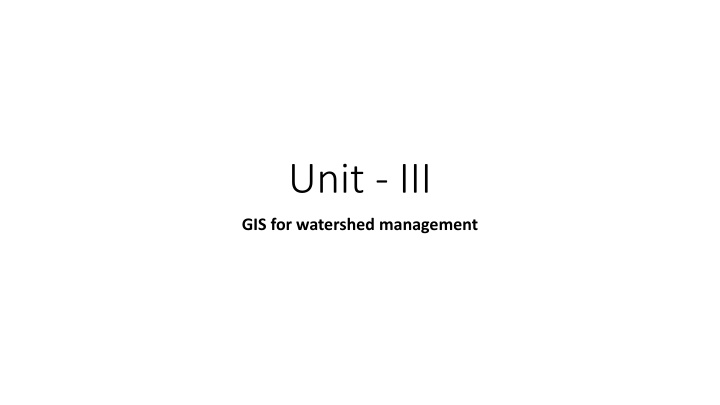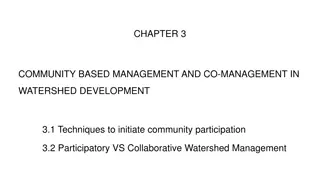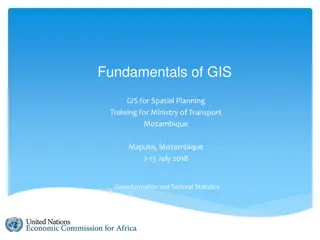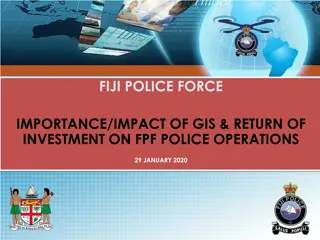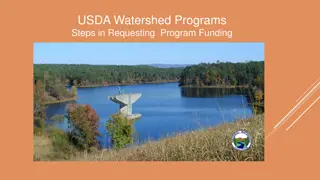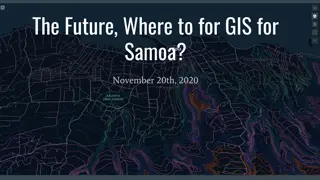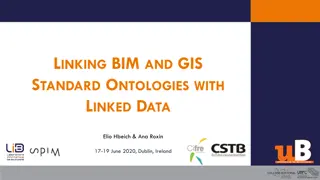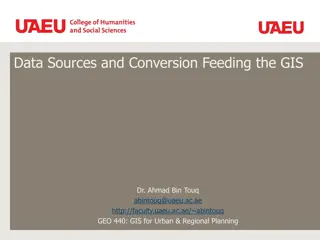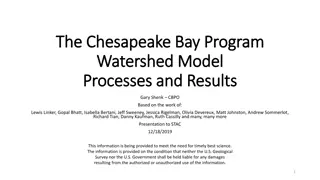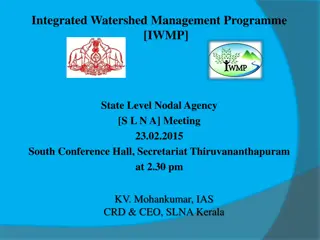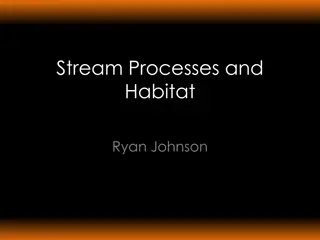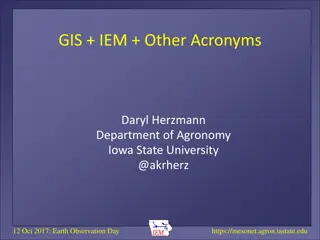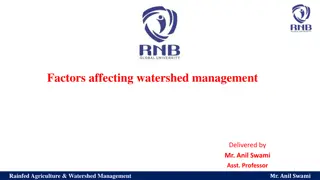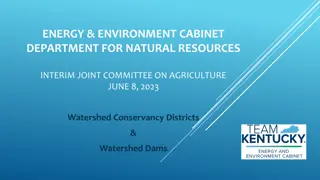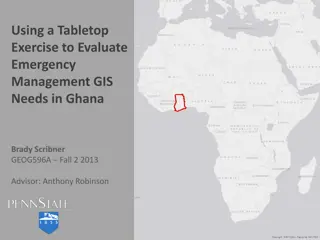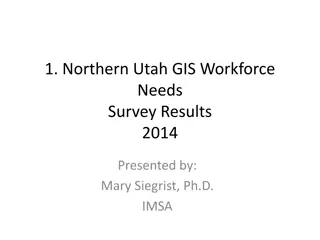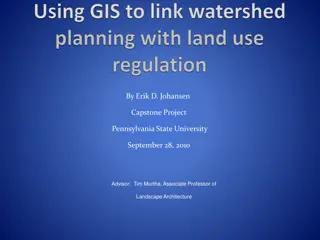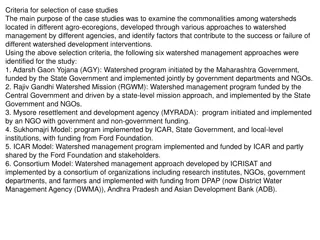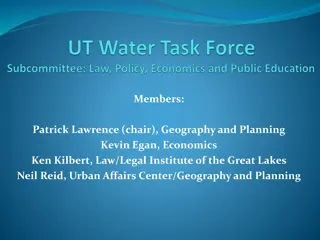GIS Application for Watershed Management
The process of using GIS for watershed management involves acquiring DEM data, processing it to derive stream features, catchment areas, and drainage points, populating data with required attributes, and using network analysis tools to derive desired matrices. GIS plays a crucial role in mapping topography, land use, soil, rainfall, and other hydrological variables. Various data sources and structures are utilized to represent parameters like topography, rainfall, soil maps, and more. Spatial data in GIS are represented as layers, coverage, or series of layers, with vector data representing features as discrete points, lines, and polygons, while raster data represents the landscape as a matrix of cells. Data for GIS applications can be sourced from digital/analog formats provided by organizations and websites. Geomorphology maps, soil maps, satellite images, and other data sources contribute to effective watershed management through GIS analysis.
Download Presentation

Please find below an Image/Link to download the presentation.
The content on the website is provided AS IS for your information and personal use only. It may not be sold, licensed, or shared on other websites without obtaining consent from the author.If you encounter any issues during the download, it is possible that the publisher has removed the file from their server.
You are allowed to download the files provided on this website for personal or commercial use, subject to the condition that they are used lawfully. All files are the property of their respective owners.
The content on the website is provided AS IS for your information and personal use only. It may not be sold, licensed, or shared on other websites without obtaining consent from the author.
E N D
Presentation Transcript
Unit - III GIS for watershed management
Basic steps in typical GIS application for Basic steps in typical GIS application for watershed watershed Acquisition of DEM data from satellite image/ toposheet. Conduct DEM processing to derive stream, catchment and drainage point features. Populate data with required attributes Use network analysis and ARChydro tools to derive desired matrices. GIS have become an integral part of hydrology GIS maps: topography, land use and land cover, soil, rainfall and meteorological variables.
GIS data sources & data GIS data sources & data structures structures Variety of data sources and structure for a single hydrological parameter For eg: topography can be represented by a series of point elevations, contour lines, TIN, elevations in a gridded or rectangular coordinated systems Rainfall: Time series at a point, array of rainfall rates derived from RADAR, gridded array of rainfall rates, isohyetal contours. Infiltration rates Soil maps Evapotranspiration rates or hydraulic roughness Raster array of remotely senesed surrogate measures.
GIS spatial Data GIS spatial Data Model Model Spatial data are referred to as layers, coverage or series of layers Vector data represent features as discrete point, lines and polygons. Raster data represent the landscape as a rectangular matrix of square cells (pixel)
Data Source Digital/ Analog Format Website/ Organization Survey Hyderabad Access Drainage Toposheet Digital/ Analog Raster of India, Payable Drainage Toposheet 1;250,000 Scale of Digital Raster University of Texas website Free Drainage OpenStreetMap Digital Vector Openstreet Map Free Elevation (Contour, Triangulated Station, Bench Mark) Toposheet Digital/ Analog Raster Survey Hyderabad of India, Payable Toposheet 1;250,000 Scale of Digital Raster University of Texas website Free DEM CartoSat DEM SRTM Satellite Image Digital Digital Digital Raster Raster Raster Bhuvan EarthExplorer Bhuvan, Explorer IMD Free Free Free LU/LC Earth Meteorological Data IMD Digital Tabular Data Payable Geology Map Digital/ Analog Raster Geological Survey of India Payable
Geomorphology Map Digital/ Analog Raster Geological of India Survey Payable Satellite Image Digital Raster Bhuvan, Explorer Earth Free Soil Map Digital/ Analog Raster Soil and Land Use survey Payable Satellite Image Digital Raster Bhuvan, Explorer Earth Free Lineament Satellite Image Digital Raster Bhuvan, Explorer Earth Free Land Parcel Map Cadastral Map Analog Raster Village Administrative Office/ Taluk Office Free Depth of Water Table - Analog/ Digital Tabular PWD/ TWAD Free/ Payable Field Visit Analog/ Digital Vector Using Piezometer Instrument cost
WATERSHED WATERSHED DELINEATION DELINEATION Manual Method Data Used Toposheet Source: Survey of India Scale: 1: 50,000 or 1: 25,000
Toposheet of Survey India can be used for watershed delineation. Toposheet has to be Georeferenced in GIS environment. Then referencing system and projections have to be defined. Three feature classes have to be created, two in line type and one in polygon. Using the one line feature class streams present in the toposheet has to be digitized. Then contours were digitized. Finally using the contours and streams the watershed boundary has to be manually digitized
Semi- automatic Data used Toposheet Source: Survey of India Scale: 1: 50,000 or 1: 25,000
Toposheet of Survey India can be used for watershed delineation. Toposheet has to be Georeferenced in GIS environment. Then referencing system and projections have to be defined. Three feature classes have to be created, two in line type and one in polygon. Using the one line feature class streams present in the toposheet has to be digitized. Then contours were digitized. In the attribute table of streams, a field was added and the stream order was entered as attribute information. Convert the stream to raster using stream order as field. From the contours, TIN was created. TIN is converted to DEM. Using DEM and raster stream, the watershed was delineated using watershed tool in Hydrology tool. The watershed thus created is of raster format
Automatic Method Data Used DEM Source: SRTM DEM from Earth Explorer Resolution: 90m
Arc SWAT is an open source tool bar which can be added as a extension to ArcGIS. Using Arc SWAT, it is possible to delineate the watershed. DEM has to be added as the input. The tool automatically fills the pits in the DEM and executes flow direction, flow direction and streams one after the other. Then it is necessary to provide outlet point manually. After providing it, watershed will be delineated and if needed sub- watersheds can also be derived from it. The output is based on the DEM data that we provide. High resolution DEM provides accurate delineation and vice-versa.
Spatial Spatial Perspective Perspective It is very useful in the establishment of linkages between various types of process i.e. hydrological process, soil erosion, vegetation cover, human activities et., and also interaction between them.
REPRESENTATION OF SURFACE AND SUB REPRESENTATION OF SURFACE AND SUB SURFACES SURFACES DEMs, TINs, and contours available for surface representation Cross section shown by fencing, stacked surfaces and true 3D volumes beyond the scope Wire-frame models capable of displaying geological cross sections and borehole geophysical data Selection of particular spatial data source Data structure, file format, quantization and error propagation GIS offers efficient algorithms for dealing with most of data Surface generation Spatial resolution and information content Drainage networks and resolution Spatially variable precipitation
